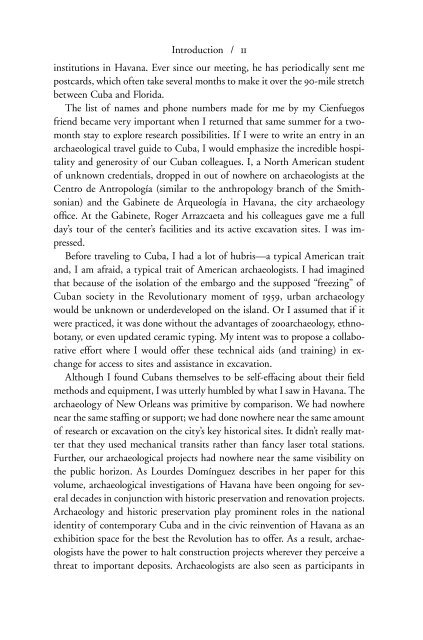Dialogues in Cuban Archaeology
by L. Antonio Curet, Shannon Lee Dawdy, and Gabino La Rosa Corzo
by L. Antonio Curet, Shannon Lee Dawdy, and Gabino La Rosa Corzo
You also want an ePaper? Increase the reach of your titles
YUMPU automatically turns print PDFs into web optimized ePapers that Google loves.
Introduction / 11<br />
<strong>in</strong>stitutions <strong>in</strong> Havana. Ever s<strong>in</strong>ce our meet<strong>in</strong>g, he has periodically sent me<br />
postcards, which often take several months to make it over the 90-mile stretch<br />
between Cuba and Florida.<br />
The list of names and phone numbers made for me by my Cienfuegos<br />
friend became very important when I returned that same summer for a twomonth<br />
stay to explore research possibilities. If I were to write an entry <strong>in</strong> an<br />
archaeological travel guide to Cuba, I would emphasize the <strong>in</strong>credible hospitality<br />
and generosity of our <strong>Cuban</strong> colleagues. I, a North American student<br />
of unknown credentials, dropped <strong>in</strong> out of nowhere on archaeologists at the<br />
Centro de Antropología (similar to the anthropology branch of the Smithsonian)<br />
and the Gab<strong>in</strong>ete de Arqueología <strong>in</strong> Havana, the city archaeology<br />
of¤ce. At the Gab<strong>in</strong>ete, Roger Arrazcaeta and his colleagues gave me a full<br />
day’s tour of the center’s facilities and its active excavation sites. I was impressed.<br />
Before travel<strong>in</strong>g to Cuba, I had a lot of hubris—a typical American trait<br />
and, I am afraid, a typical trait of American archaeologists. I had imag<strong>in</strong>ed<br />
that because of the isolation of the embargo and the supposed “freez<strong>in</strong>g” of<br />
<strong>Cuban</strong> society <strong>in</strong> the Revolutionary moment of 1959, urban archaeology<br />
would be unknown or underdeveloped on the island. Or I assumed that if it<br />
were practiced, it was done without the advantages of zooarchaeology, ethnobotany,<br />
or even updated ceramic typ<strong>in</strong>g. My <strong>in</strong>tent was to propose a collaborative<br />
effort where I would offer these technical aids (and tra<strong>in</strong><strong>in</strong>g) <strong>in</strong> exchange<br />
for access to sites and assistance <strong>in</strong> excavation.<br />
Although I found <strong>Cuban</strong>s themselves to be self-effac<strong>in</strong>g about their ¤eld<br />
methods and equipment, I was utterly humbled by what I saw <strong>in</strong> Havana. The<br />
archaeology of New Orleans was primitive by comparison. We had nowhere<br />
near the same staf¤ng or support; we had done nowhere near the same amount<br />
of research or excavation on the city’s key historical sites. It didn’t really matter<br />
that they used mechanical transits rather than fancy laser total stations.<br />
Further, our archaeological projects had nowhere near the same visibility on<br />
the public horizon. As Lourdes Domínguez describes <strong>in</strong> her paper for this<br />
volume, archaeological <strong>in</strong>vestigations of Havana have been ongo<strong>in</strong>g for several<br />
decades <strong>in</strong> conjunction with historic preservation and renovation projects.<br />
<strong>Archaeology</strong> and historic preservation play prom<strong>in</strong>ent roles <strong>in</strong> the national<br />
identity of contemporary Cuba and <strong>in</strong> the civic re<strong>in</strong>vention of Havana as an<br />
exhibition space for the best the Revolution has to offer. As a result, archaeologists<br />
have the power to halt construction projects wherever they perceive a<br />
threat to important deposits. Archaeologists are also seen as participants <strong>in</strong>


















